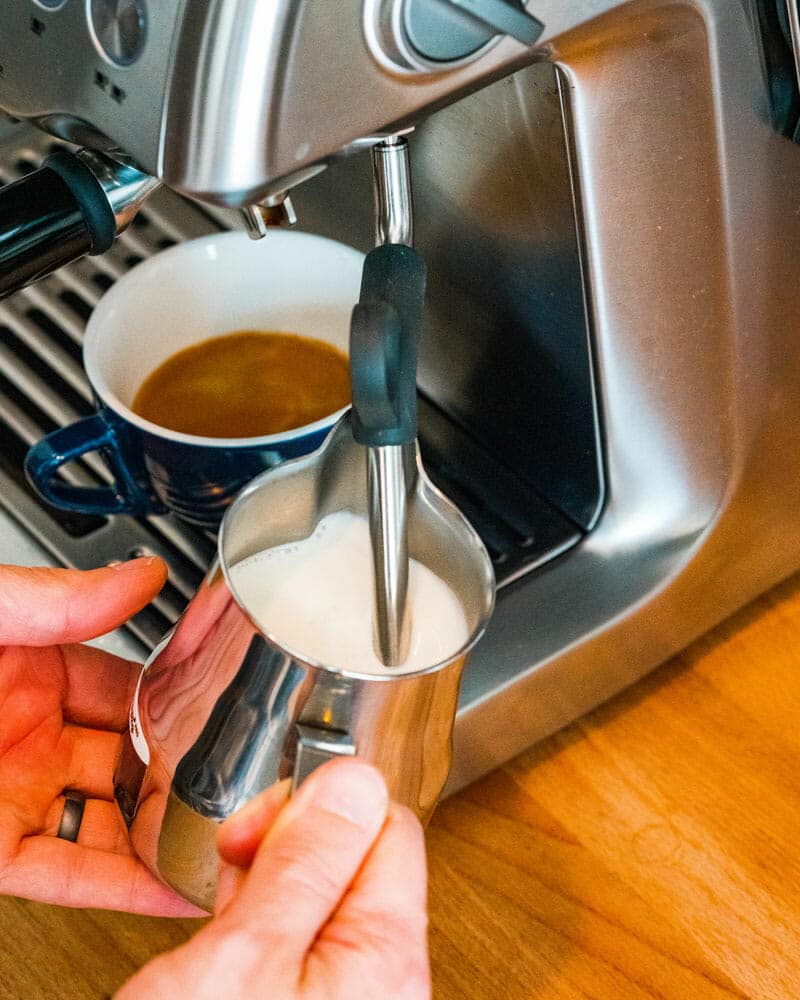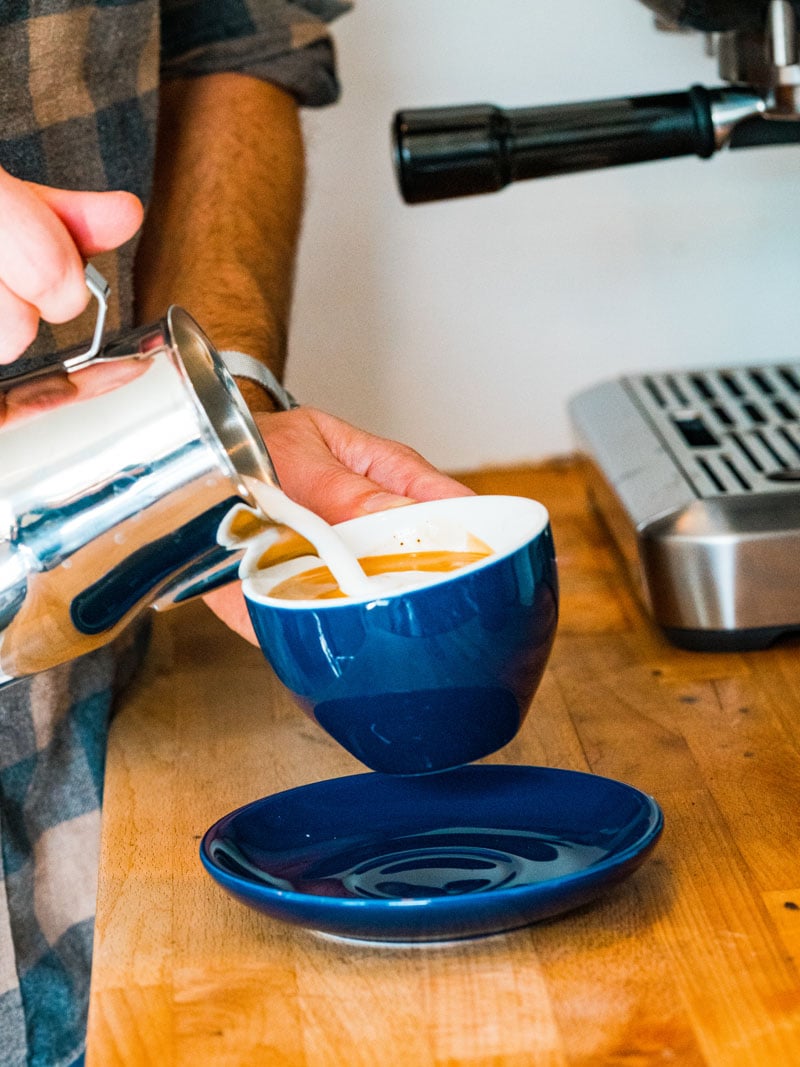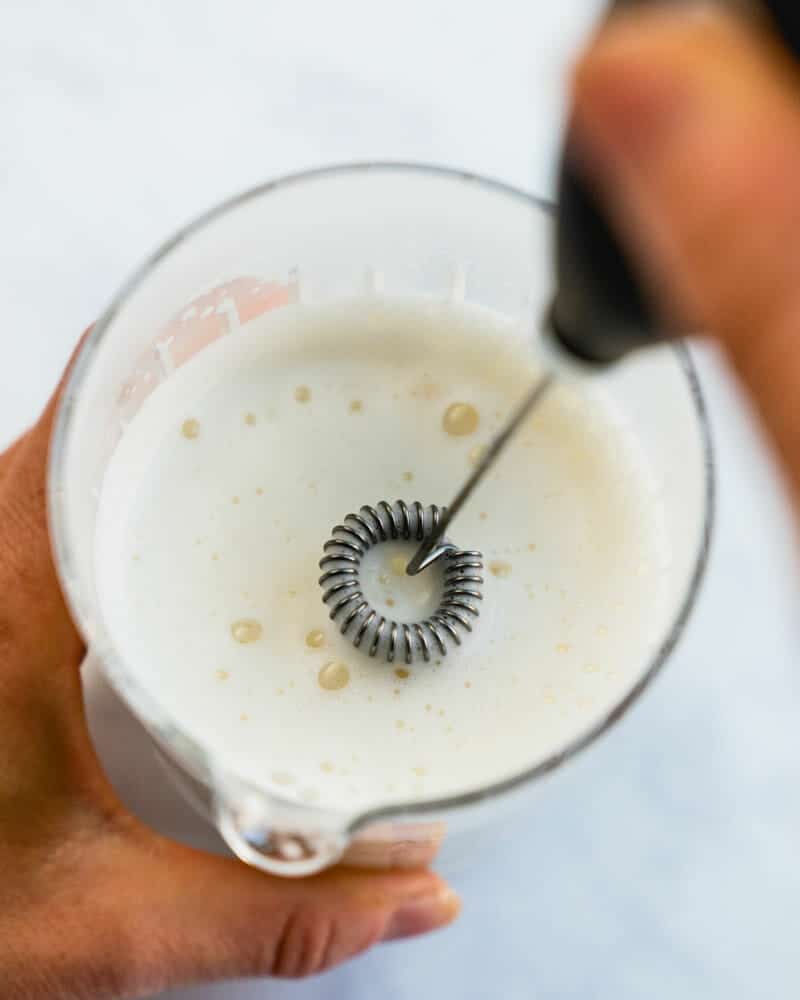Learn to make a latte at dwelling that tastes identical to a espresso store! With espresso, steamed milk, and frothy foam, it’s easy and barista-quality.

Do you know you may make a barista-quality cafe latte within the consolation of your individual dwelling? After numerous recipe assessments, I’ve found the secrets and techniques to creating lattes that rival something from Starbucks or your favourite native espresso store!
A latte is just espresso mixed with steamed milk and a skinny layer of milk foam on prime. The good factor about making this espresso drink at house is which you could management each factor to make a clean, creamy latte on the fraction of a value of your common espresso store drink.
Why You’ll Love This Latte
A traditional latte ratio is one-third espresso to two-thirds milk, which makes a clean, creamy espresso drink that’s barely much less intense than a cappuccino.
What makes it particular is the silky microfoam, a layer of froth made by steaming the milk till it has a “wet-paint” like texture. It may be tough to get to that texture and not using a steamer, however I’ll present you methods to do it with numerous instruments. Right here’s why you’ll love this latte:
- Barista-quality outcomes: I’ll present you methods to make a latte whether or not you may have an espresso machine or simply have primary kitchen instruments.
- Flexibility: You don’t want a flowery espresso maker (although that does assist!). I’ll present you methods to make robust espresso that mimics espresso utilizing a French press or Moka pot.
- Finances-friendly: A Starbucks latte prices about $5, which may add up! The substances value a fraction of the worth: and also you get the satisfaction of figuring out you made it your self.

Key Elements
Right here’s what you want for making lattes at dwelling:
- Espresso or robust espresso (2 pictures/2 ounces): Use freshly brewed espresso from an espresso machine, or make robust espresso utilizing my different strategies. Darkish roast beans work finest for that genuine espresso store espresso taste.
- Recent milk (4-6 ounces): Entire milk creates the richest, creamiest texture attributable to its fats content material. It froths properly and produces secure milk foam that holds its form. 2% milk additionally works, making much less secure foam. Milk that’s getting nearer to its expiration date doesn’t foam as properly, so be sure it’s as recent as doable.
- Optionally available sweeteners: Conventional lattes are unsweetened, however you possibly can add sugar, honey, or flavored syrups to style. Add the sweetener to the recent milk earlier than frothing.
For milk options, oat milk is my prime suggestion. It steams equally to dairy milk and makes an honest foam. Almond milk and soy milk additionally work, however they produce much less secure foam. If yow will discover barista-style plant milks, they include stabilizers that may assist make the froth.
Step-By-Step: The right way to Make a Latte at House
When you’ve received your espresso and your instruments, you will get to the good things! Right here’s methods to make a latte at dwelling (or go to the recipe):

Step 1: Brew the espresso.
Make 2 pictures of espresso or put together robust espresso utilizing one in every of these strategies:
- Espresso machine: Use a countertop espresso machine, or the price range choice, this handbook espresso maker. (See my tutorial on The right way to Make Espresso.)
- Moka pot (Bialetti): Fill with water and low, warmth on stovetop till it bubbles up. See Moka Pot Espresso.
- French press: Use double the traditional espresso grounds, steep for 4 minutes. See French Press Espresso.
- Technically you may make Aeropress espresso or use a Nespresso machine, however the taste will not be practically nearly as good.

Step 2: Warmth the milk and create the froth.
Heat 4-6 ounces of milk to 150-160°F. If utilizing a stovetop, warmth gently whereas stirring: don’t let it boil.
Then steam or froth your milk utilizing your most popular methodology (detailed strategies under). You need small, uniform bubbles that create a paint-like consistency.

Step 3: Pour the milk into the espresso.
Begin pouring from 3-4 inches excessive to assist combine the espresso and milk. Because the cup fills, carry the pitcher nearer and gradual your pour to drift the froth on prime.

Step 4: Add ending touches and revel in.
Mud with cocoa powder, cinnamon, or try some primary latte artwork for those who’re feeling adventurous (see under).
Ideas for Frothing or Steaming Milk
Steaming (utilizing an espresso machine’s steam wand) creates microfoam: tiny bubbles that give the milk a velvety, paint-like consistency good for latte artwork. Frothing (utilizing different strategies) produces bigger bubbles and a lighter, airier foam.
The important thing to both methodology is beginning with chilly, recent milk. As milk ages, its proteins break down, making it tougher to create secure foam. Milk that’s greater than every week outdated doesn’t usually froth properly.
Steaming (With an Espresso Machine)
Espresso machines make the perfect microfoam, however they are often dear. Right here’s the espresso machine I take advantage of: it’s costly however makes unimaginable high quality espresso and I take advantage of it every day! Right here’s methods to steam milk for a latte utilizing an espresso machine with steam wand:
- Pour chilly milk into a stainless-steel pitcher, filling it one-third full.
- Purge the steam wand by releasing steam for two seconds. Then place the wand tip slightly below the milk’s floor at an angle.
- Activate the steam: you’ll hear a delicate hissing. Maintain the steaming wand slightly below the floor of the milk till it doubles in dimension (it ought to take a couple of seconds). This makes foamy froth.
- Transfer the wand decrease close to the aspect of the pitcher to create a spiral vortex. This makes the silky clean microfoam bubbles and wet-paint texture that’s attribute of a latte.
- Steam till the milk reaches 150°F. Use a thermometer or decide by when your hand can’t maintain the pitcher for quite a lot of seconds.
- Faucet the pitcher on the counter and swirl to eradicate massive bubbles.
Go to my tutorial on The right way to Steam Milk for extra particulars!

Frothing (With out a Machine)
You don’t want an espresso maker with steamer to make an incredible latte at dwelling! You’ll be able to merely warmth and froth the milk, which tastes practically nearly as good. There are a couple of totally different handheld instruments you need to use to froth milk for a latte.
To learn to froth, go to my tutorial The right way to Froth Milk or head to the recipe under. Listed below are a couple of nice instruments for the house barista for frothing milk:
- Handheld milk frother (best choice): A handheld milk frother is cheap and works properly. It will get the milk extraordinarily frothy, so it’s simple to make a macchiato or cappuccino. It’s somewhat trickier to make an incredible latte with a frother, however you possibly can observe the information under to get an incredible drink.
- French press (an in depth second): You probably have a French press, it’s additionally nice for making foam! It makes a pleasant frothy foam with bubbles somewhat bigger than the frother.
- Whisk (use in a pinch): A whisk can works, but it surely makes a looser foam with bigger bubbles. This methodology generates much less foam than the frother or French press.
Ratios and Serving Sizes
The traditional latte ratio is between 1:2 to 1:3 (one half espresso to 2 or three elements milk), however this varies with serving dimension:
- 6-ounce latte (conventional dimension): 2 ounces espresso (double shot), 4 ounces steamed milk
- 12-ounce latte (tall): 2 ounces espresso (double shot), 9-10 ounces steamed milk
- 16-ounce latte (grande): 3 ounces espresso (triple shot), 12-13 ounces steamed milk
Tip: A latte cup is sweet for making lattes at dwelling, as a result of it’s designed to carry precisely the correct quantity of espresso and foam! Right here’s the 6 ounce latte cup that I take advantage of. (It additionally can be utilized for treats like mug truffles!).
For comparability, cappuccino makes use of equal elements espresso, steamed milk, and foam (1:1:1), and a a flat white makes use of a 1:2 ratio with a really skinny layer of froth.

Latte Artwork Fundamentals
When you’ve mastered making a do-it-yourself latte, latte artwork turns into a enjoyable problem. My husband Alex spent months working towards earlier than efficiently pouring his first coronary heart design. It requires quite a lot of follow!
The muse of latte artwork is microfoam with the correct consistency: the milk ought to look shiny and transfer like moist paint once you swirl the pitcher. As you would possibly anticipate, that is best to realize with the steam wand of an espresso machine.
The essential approach includes tilting your cup at 45 levels, pouring steadily into the middle, then bringing the pitcher near the floor as you create your design. For detailed directions, try my full latte artwork tutorial.
Taste Concepts and Add-Ins
Whereas I really like a traditional latte, these taste variations maintain issues thrilling:
- Vanilla Latte: Add ½ to 1 tablespoon of vanilla syrup to your milk earlier than steaming. Get my Vanilla Latte recipe.
- Lavender Latte: Add 1 tablespoon lavender syrup. Get my Lavender Latte recipe.
- Pumpkin Spice Latte: Combine pumpkin and maple syrup into the espresso. See my Pumpkin Spice Latte Recipe.
- Soiled Chai Latte: This fusion of espresso and tea creates an extremely advanced taste profile: strive my Soiled Chai Latte recipe.
- Iced Latte: Pour espresso over ice, add chilly milk (no frothing wanted!), and sweeten to style. That is a simple strategy to make a latte with out particular tools!
Steadily requested questions
A cappuccino has equal elements espresso, steamed milk and foam (⅓ every). A latte has ⅓ espresso and a couple of/3 steamed milk, with a skinny layer of froth on prime. Right here’s a visible chart.
Learn extra in my article in regards to the distinction between a latte and a cappuccino.
Whereas conventional lattes require espresso, you may make an approximation utilizing very robust common espresso. Brew darkish roast espresso at double energy: use twice the traditional quantity of grounds. A French press or pour over methodology works finest for this.
For true barista-quality lattes, an espresso machine with a steam wand is right. The Breville Barista Specific affords glorious worth, combining a grinder, espresso maker, and steam wand. For price range choices, a Nespresso machine with an Aeroccino milk frother produces constant outcomes, or you need to use a handbook espresso maker. If you have already got a espresso maker, merely add a very good milk frother.
Begin by perfecting your milk texture: latte artwork is not possible with out correctly steamed milk. Watch video tutorials to know pouring strategies, then start with easy patterns like hearts or dots. Use entire milk for finest outcomes. Most significantly, follow every day: my husband Alex made horrible latte artwork for 3 months earlier than reaching something that appeared respectable.
See my detailed latte artwork tutorial for step-by-step steerage.
Dietary notes
This latte recipe is vegetarian and gluten-free.
The right way to Make a Latte (Cafe Latte)
Right here’s methods to make a latte at dwelling! This cafe latte has the perfect creamy physique and frothy milk, and tastes higher than a espresso store.
- Prep Time: 10 minutes
- Cook dinner Time: 0 minutes
- Complete Time: 10 minutes
- Yield: 1 drink
- Class: Drink
- Technique: Espresso
- Delicacies: Espresso
- Food regimen: Vegetarian
Elements
- 2 espresso pictures (2 ounces)
- 4 ounces (½ cup) recent entire milk*
Directions
- Make the espresso: Use an espresso machine or handbook espresso maker to make two pictures of espresso and pour it right into a mug (or strive our Aeropress Espresso).
- Steaming methodology (espresso machine): Place the milk in a pitcher. Maintain the steaming wand slightly below the floor of the milk till it doubles in dimension. This makes foamy froth. Then, transfer the steaming wand decrease and close to the aspect of the pitcher to create a spiral vortex. This makes the silky clean microfoam bubbles and wet-paint texture that’s attribute of a latte. Steam till the milk reaches 150 levels Fahrenheit (use a thermometer or decide by when your hand can’t maintain the pitcher for quite a lot of seconds).
- OR, warmth the milk to scalding and foam it (with out espresso machine): Warmth the milk to 150 levels Fahrenheit, which is scorching to the contact however not simmering. Measure with a meals thermometer, or you possibly can approximate by testing along with your finger. Use a milk frother, French press or whisk to froth milk into small, even bubbles. For a latte you’ll need small bubbles and calmly thickened milk (for those who’re utilizing a milk frother, don’t go too far: you need the milk to combine in with the espresso so that you don’t want an excessive amount of froth). For the French press methodology, be aware that it’s helpful to have at the very least 1 cup to have extra milk to work with: this makes sufficient for two drinks. We extremely advocate studying The right way to Froth Milk if that is your first time frothing. Wait 30 seconds to 1 minute to get the froth to include into the milk and separate barely (precise timing is determined by your foaming methodology).
- Serve: Faucet the milk container on counter and swirl it to interrupt down any massive bubbles. Pour milk into middle of the espresso, ending with gentle foam.
Notes
- Entire milk works finest; milk that could be a few weeks outdated might not froth. You too can use oat milk for a vegan latte. The milk frother works properly; for the French press pump vigorously till frothy, about 25 occasions. Don’t overwhip, as the froth will deflate!
- For iced latte, go to my Iced Latte recipe.
- Retailer-bought syrups can substitute plain sweetener for flavored variations.
- Clear frothing tools instantly after use to forestall milk residue buildup.
- For stronger espresso taste, use 3 pictures of espresso or scale back milk to 3-4 ounces.
window.trCommon={“minRating”:6,”ajaxurl”:”https://www.acouplecooks.com/wp-admin/admin-ajax.php”,”ratingNonce”:””,”postId”:79850};
window.TastyRecipes = window.TastyRecipes || {};
window.TastyRecipes.smoothScroll = {
init() {
doc.addEventListener( ‘click on’, ( e ) => {
let anchor = e.goal;
if ( anchor.tagName !== ‘A’ ) {
anchor = anchor.closest( ‘a.tasty-recipes-scrollto’ );
}
if ( ! anchor || ! anchor.classList.incorporates( ‘tasty-recipes-scrollto’ ) ) {
return;
}
const elementHref = anchor.getAttribute( ‘href’ );
if ( ! elementHref ) {
return;
}
e.preventDefault();
this.goToSelector( elementHref );
});
},
goToSelector( selector ) {
const factor = doc.querySelector( selector );
if ( ! factor ) {
return;
}
factor.scrollIntoView( { habits: ‘clean’ } );
}
};
doc.addEventListener(
‘DOMContentLoaded’,
() => window.TastyRecipes.smoothScroll.init()
);
window.TastyRecipes = window.TastyRecipes || {};
window.TastyRecipes.cookMode = {
wakeLockApi: false,
wakeLock: false,
cookModeSelector: ‘.tasty-recipes-cook-mode’,
init() {
if (“wakeLock” in navigator && “request” in navigator.wakeLock) {
this.wakeLockApi = navigator.wakeLock;
}
const cookModes = doc.querySelectorAll(this.cookModeSelector);
if (cookModes.size > 0) {
for (const cookMode of cookModes) {
if (this.wakeLockApi) {
cookMode.querySelector(‘enter[type=”checkbox”]’).addEventListener(“change”, occasion => {
this.checkboxChange(occasion.goal);
}, false);
} else {
cookMode.type.show = “none”;
}
}
}
},
checkboxChange(checkbox) {
if (checkbox.checked) {
this.lock();
} else {
this.unlock();
}
},
setCheckboxesState(state) {
const checkboxes = doc.querySelectorAll(this.cookModeSelector + ‘ enter[type=”checkbox”]’);
for (const checkbox of checkboxes) {
checkbox.checked = state;
}
},
async lock() {
strive {
this.wakeLock = await this.wakeLockApi.request(“display”);
this.wakeLock.addEventListener(“launch”, () => {
this.wakeLock = false;
this.setCheckboxesState(false);
});
this.setCheckboxesState(true);
} catch (error) {
this.setCheckboxesState(false);
}
},
unlock() {
if (this.wakeLock) {
this.wakeLock.launch();
this.wakeLock = false;
}
this.setCheckboxesState(false);
}
};
(perform(callback) {
if (doc.readyState !== “loading”) {
callback();
} else {
doc.addEventListener(“DOMContentLoaded”, callback);
}
})(() => {
window.TastyRecipes.cookMode.init();
});
window.TastyRecipes = window.TastyRecipes || {};
window.TastyRecipes.staticTooltip = {
factor: null,
tooltipElement: null,
deleting: false,
init( factor ) {
if ( this.deleting ) {
return;
}
this.factor = factor;
this.buildElements();
},
destroy() {
if ( ! this.tooltipElement || this.deleting ) {
return;
}
this.deleting = true;
this.tooltipElement.classList.take away( ‘opened’ );
setTimeout( () => {
this.tooltipElement.take away();
this.deleting = false;
}, 500 );
},
buildElements() {
const tooltipElement = doc.createElement( ‘div’ );
tooltipElement.classList.add( ‘tasty-recipes-static-tooltip’);
tooltipElement.setAttribute( ‘id’, ‘tasty-recipes-tooltip’ );
const currentTooltipElement = doc.getElementById( ‘tasty-recipes-tooltip’ );
if ( currentTooltipElement ) {
doc.physique.replaceChild( tooltipElement, currentTooltipElement );
} else {
doc.physique.appendChild( tooltipElement );
}
this.tooltipElement = doc.getElementById( ‘tasty-recipes-tooltip’ );
},
present() {
if ( ! this.tooltipElement ) {
return;
}
const tooltipTop = this.factor.getBoundingClientRect().prime
+ window.scrollY
– 10 // 10px offset.
– this.tooltipElement.getBoundingClientRect().top;
const tooltipLeft = this.factor.getBoundingClientRect().left
– ( this.tooltipElement.getBoundingClientRect().width / 2 )
+ ( this.factor.getBoundingClientRect().width / 2 ) – 1;
const posLeft = Math.max( 10, tooltipLeft );
this.maybeRemoveTail( posLeft !== tooltipLeft );
this.tooltipElement.setAttribute( ‘type’, ‘prime:’ + tooltipTop + ‘px;left:’ + posLeft + ‘px;’ );
this.tooltipElement.classList.add( ‘opened’ );
},
maybeRemoveTail( removeTail ) {
if ( removeTail ) {
this.tooltipElement.classList.add( ‘tr-hide-tail’ );
} else {
this.tooltipElement.classList.take away( ‘tr-hide-tail’ );
}
},
changeMessage( message ) {
if ( ! this.tooltipElement ) {
return;
}
this.tooltipElement.innerHTML = message;
}
};
window.TastyRecipes.ajax = {
sendPostRequest( url, information, success, failure ) {
const xhr = new XMLHttpRequest();
xhr.open( ‘POST’, url, true );
xhr.ship( this.preparePostData( information ) );
xhr.onreadystatechange = () => {
if ( 4 !== xhr.readyState ) {
return;
}
if ( xhr.standing === 200 ) {
success( JSON.parse( xhr.responseText ) );
return;
}
failure( xhr );
};
xhr.onerror = () => {
failure( xhr );
};
},
preparePostData( information ) {
const formData = new FormData();
for ( const key in information ) {
formData.append( key, information[key] );
}
return formData;
},
};
window.TastyRecipes.scores = {
defaultRating: 0,
currentRatingPercentage: 100,
savingRating: false,
init( minRating ) {
this.minRating = minRating;
this.formWatchRating();
this.closeTooltipWhenClickOutside();
this.addBodyClassBasedOnSelectedRating();
this.backwardCompFormRatingPosition();
},
formWatchRating() {
const scores = doc.querySelectorAll(‘.tasty-recipes-no-ratings-buttons [data-rating]’);
if ( scores.size {
occasion.preventDefault();
this.defaultRating = occasion.goal.closest( ‘.checked’ ).dataset.score;
this.setCheckedStar( occasion.goal );
this.maybeSendRating( this.defaultRating, occasion.goal );
this.setRatingInForm( this.defaultRating );
} );
}
},
closeTooltipWhenClickOutside() {
window.addEventListener( ‘click on’, e => {
// Bailout (do not take away the tooltip) when the clicked factor is a score star, or it is the tooltip itself.
if ( e.goal.closest( ‘.tasty-recipes-rating’ ) || e.goal.classList.incorporates( ‘tasty-recipes-static-tooltip’ ) ) {
return;
}
window.TastyRecipes.staticTooltip.destroy();
} );
},
setRatingInForm( score ) {
const ratingInput = doc.querySelector( ‘#reply .tasty-recipes-rating[value=”‘ + rating + ‘”]’ );
if ( ! ratingInput ) {
return;
}
ratingInput.click on();
},
addBodyClassBasedOnSelectedRating() {
const ratingInputs = doc.querySelectorAll( ‘enter.tasty-recipes-rating’ );
if ( ! ratingInputs ) {
return;
}
for ( const ratingInput of ratingInputs ) {
ratingInput.addEventListener( ‘click on’, currentEvent => {
const selectedRating = currentEvent.goal.getAttribute( ‘worth’ );
this.handleBodyClassByRating( selectedRating );
this.toggleCommentTextareaRequired( selectedRating );
} );
}
},
handleBodyClassByRating( score ) {
if ( score < this.minRating ) {
doc.physique.classList.take away( 'tasty-recipes-selected-minimum-rating' );
return;
}
doc.physique.classList.add( 'tasty-recipes-selected-minimum-rating' );
},
toggleCommentTextareaRequired( score ) {
const commentTextarea = doc.getElementById( 'remark' );
if ( ! commentTextarea ) {
return;
}
if ( score {
window.TastyRecipes.staticTooltip.changeMessage( response.information.message );
window.TastyRecipes.staticTooltip.present();
this.updateAverageText( response.information, recipeCardElement );
this.maybeFillCommentForm( response.information );
// Disguise the tooltip after 5 seconds.
setTimeout( () => {
this.maybeResetTooltip( recipeCardElement, response.information, score );
}, 5000 );
},
() => {
this.resetTooltip( recipeCardElement );
}
);
},
updateAverageText( information, recipeCardElement ) {
if ( ! information.common ) {
return;
}
this.setRatingPercent( information );
if ( ! information.depend ) {
return;
}
const quickLink = doc.querySelector( ‘.tasty-recipes-rating-link’ );
if ( quickLink ) {
this.setTextInContainer( quickLink, information );
this.setPartialStar( quickLink );
}
const cardStars = recipeCardElement.querySelector( ‘.tasty-recipes-ratings-buttons’ );
cardStars.dataset.trDefaultRating = information.common;
this.setTextInContainer( recipeCardElement.querySelector( ‘.tasty-recipes-rating’ ), information );
},
setTextInContainer( container, information ) {
if ( ! container ) {
return;
}
if ( information.label ) {
const ratingLabelElement = container.querySelector( ‘.rating-label’ );
if ( ratingLabelElement ) {
ratingLabelElement.innerHTML = information.label;
}
return;
}
const averageElement = container.querySelector( ‘.common’ );
if ( averageElement ) {
averageElement.textContent = information.common;
}
const countElement = container.querySelector( ‘.depend’ );
if ( countElement ) {
countElement.textContent = information.depend;
}
},
setPartialStar( container ) {
const highestStar = container.querySelector( ‘[data-rating=”‘ + Math.ceil( this.defaultRating ) + ‘”]’ );
if ( highestStar ) {
highestStar.dataset.trClip = this.currentRatingPercentage;
}
},
setRatingPercent( information ) {
this.defaultRating = information.common.toFixed( 1 );
const elements = information.common.toFixed( 2 ).toString().cut up( ‘.’ );
this.currentRatingPercentage = elements[1] ? elements[1] : 100;
if ( this.currentRatingPercentage === ’00’ ) {
this.currentRatingPercentage = 100;
}
},
setCheckedStar( goal ) {
const cardRatingContainer = goal.closest( ‘.tasty-recipes-ratings-buttons’ );
const selectedRatingElement = cardRatingContainer.querySelector( ‘[data-tr-checked]’ );
if ( selectedRatingElement ) {
delete selectedRatingElement.dataset.trChecked;
}
const thisStar = goal.closest( ‘.tasty-recipes-rating’ );
thisStar.dataset.trChecked = 1;
thisStar.querySelector( ‘[data-tr-clip]’ ).dataset.trClip = 100;
},
maybeFillCommentForm( information ) {
if ( ! information.remark || ! information.remark.content material ) {
return;
}
const commentForm = doc.querySelector( ‘#commentform’ );
if ( ! commentForm ) {
return;
}
const commentBox = commentForm.querySelector( ‘[name=comment]’ );
if ( ! commentBox || commentBox.worth ) {
return;
}
// Add remark particulars for enhancing.
commentBox.innerHTML = information.remark.content material;
if ( information.remark.title ) {
commentForm.querySelector( ‘[name=author]’ ).worth = information.remark.title;
commentForm.querySelector( ‘[name=email]’ ).worth = information.remark.electronic mail;
}
},
maybeResetTooltip( recipeCardElement, information, score ) {
if ( this.savingRating === score ) {
this.resetTooltip( recipeCardElement, information );
}
},
resetTooltip( recipeCardElement, information ) {
window.TastyRecipes.staticTooltip.destroy();
this.savingRating = false;
// Reset the default score.
const cardRatingContainer = recipeCardElement.querySelector( ‘.tasty-recipes-ratings-buttons’ );
if ( cardRatingContainer ) {
this.defaultRating = ( information && information.common ) ? information.common.toFixed(1) : cardRatingContainer.dataset.trDefaultRating;
cardRatingContainer.dataset.trDefaultRating = this.defaultRating;
this.resetSelectedStar( cardRatingContainer, information );
}
},
resetSelectedStar( cardRatingContainer ) {
const selectedRatingElement = cardRatingContainer.querySelector( ‘[data-rating=”‘ + Math.ceil( this.defaultRating ) + ‘”]’ );
if ( selectedRatingElement ) {
selectedRatingElement.querySelector( ‘[data-tr-clip]’ ).dataset.trClip = this.currentRatingPercentage;
selectedRatingElement.parentNode.dataset.trChecked = 1;
}
const previousSelectedElement= cardRatingContainer.querySelector( ‘[data-tr-checked]’ );
if ( previousSelectedElement ) {
const currentSelectedRating = previousSelectedElement.querySelector(‘[data-rating]’);
if ( currentSelectedRating !== selectedRatingElement ) {
delete previousSelectedElement.dataset.trChecked;
}
}
},
backwardCompFormRatingPosition() {
const ratingsButtons = doc.querySelector( ‘#reply .tasty-recipes-ratings-buttons, #tasty-recipes-comment-rating .tasty-recipes-ratings-buttons’ );
if ( ! ratingsButtons ) {
return;
}
const ratingsButtonsStyles = window.getComputedStyle(ratingsButtons);
if ( ! ratingsButtonsStyles.show.contains( ‘flex’ ) ) {
ratingsButtons.type.course = ‘rtl’;
}
if ( typeof tastyRecipesRating !== ‘undefined’ ) {
// Choose the score that was beforehand chosen in admin.
ratingsButtons.querySelector( ‘.tasty-recipes-rating[value=”‘ + tastyRecipesRating + ‘”]’ ).checked = true;
}
const ratingSpans = ratingsButtons.querySelectorAll( ‘.tasty-recipes-rating’ );
for (const ratingSpan of ratingSpans) {
ratingSpan.addEventListener( ‘click on’, occasion => {
if ( ratingSpan === occasion.goal ) {
return;
}
ratingSpan.previousElementSibling.click on();
} );
}
}
};
(perform(callback) {
if (doc.readyState !== “loading”) {
callback();
} else {
window.addEventListener( ‘load’, callback );
}
})(() => {
window.TastyRecipes.scores.init( window.trCommon ? window.trCommon.minRating : 4 );
});







